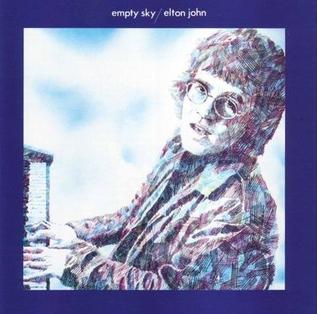Empty Sky
| Empty Sky | ||||
|---|---|---|---|---|
 |
||||
| Studio album by Elton John | ||||
| Released | 6 June 1969 (UK) 13 January 1975 (US) |
|||
| Recorded | December 1968 – April 1969 | |||
| Studio | Dick James Music Studios, London | |||
| Genre | Psychedelic rock, soft rock,progressive pop, folk rock | |||
| Length | 41:00 (original release) 54:56 (1995 reissue) |
|||
| Label |
DJM (UK) MCA (US) |
|||
| Producer | Steve Brown | |||
| Elton John chronology | ||||
|
||||
| Professional ratings | |
|---|---|
| Review scores | |
| Source | Rating |
| AllMusic | |
Empty Sky is the debut studio album by British singer-songwriter Elton John, released on 6 June 1969. It would not be released in the United States until January 1975 (on MCA), with different cover art, well after John's fame had been established internationally.
Recorded during the winter of 1968 and spring of 1969 in a DJM 8-track studio, Empty Sky is the only album in the early part of his career not produced by Gus Dudgeon, instead helmed by friend and DJM staffer Steve Brown. The album was released in the UK in both stereo and mono with the latter now being a rare collector's item.
John plays harpsichord on several tracks, including "Skyline Pigeon", which John has described as being "the first song Bernie and I ever got excited about that we ever wrote."
John used musicians who were either his or Brown's friends. Guitarist Caleb Quaye and drummer Roger Pope, both members of the band Hookfoot at the time, played on many of the tracks. (Quaye and Pope would rejoin John a few years later as part of his studio and touring band behind Rock of the Westies in 1975 and Blue Moves in 1976.) Tony Murray from The Troggs played bass. Empty Sky is the first appearance with John of then Plastic Penny and Spencer Davis Group member Nigel Olsson, who played drums on "Lady What's Tomorrow?" (Olsson and fellow Spencer Davis bandmate, bassist Dee Murray, would soon join John as his early '70s touring band.) Also listed in the production credits is Clive Franks, who would later produce John's live sound in concert for a tremendous amount of his touring career, as well as occasionally co-produce with John on albums such as A Single Man and 21 at 33. The original sleeve design was done by David Larkham (billed as "Dave"), who would go on to create designs for John and other artists.
...
Wikipedia
